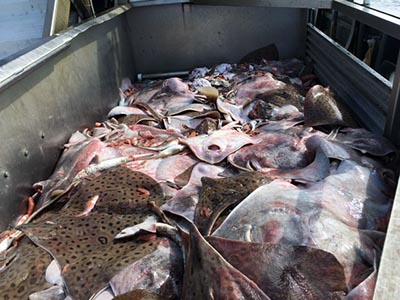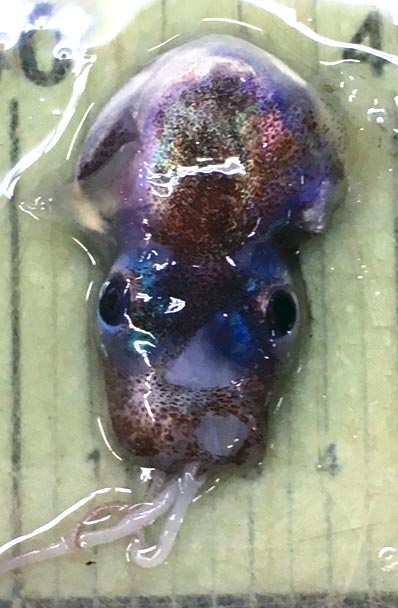Leg III: 2017 Spring Bottom Trawl Survey
Photo credit for all images in this post NOAA/GARFO/William Duffy

Spotted tinselfish, family Zeidae, caught at 275 meters.
Welcome aboard Leg 3 of the NMFS NEFSC bottom trawl survey. One of the questions I get asked frequently when I get back home is: what are the coolest types of fish you see out there? My answer is always the same, the deep-water fish species. They are interesting, they look like aliens, and I am pretty sure some of the more horrific monsters that one would see on TV or in the movies was inspired by a fish caught from the deep depths of the sea. So while I am guest blogging out here, I thought it would be great to share a few pictures from a couple of our deep-water stations with the rest of you.
In our first deep station of the trip, we towed at 300 meters (900 feet). When we dumped the bag in the checker there were almost 2,000 pounds of large barndoor skates. Also brought up from 30 meters were some cutlassfish, pearlsides, shortnose green eyes, and a grenadier. One of the more interesting types of fishes that come up from the depths are the barracudinas from the family Paralepididae. The specimen in the slideshow below was about 30cm long. . The other fish pictured here: pearlside, family Sternoptychidae; short-nose green eye, family Chlorophthalmidae; and grenadier, family Macrouridae, are all commonly seen in the deeper waters of the Gulf of Maine and Georges Bank.

Barndoor skates

Barracudina

Pearlside

shortnose green eye

Grenadier

Lanternfish
In another station, we towed at 275 meters and caught a few more interesting deep-water fish species that I think most people have never seen before. These are some of the more colorful, interestingly shaped, and bizarre-looking fish species that we catch on these surveys. The first is an oddly shaped fish called a spotted tinselfish from the family Zeidae, pictured at the top of this post. We also had a few “large” Myctophids, also called lanternfishes (above). Most fish from this family are relatively small, with the largest species not getting more than 30 cm in length. These fish have light producing organs called photophores and luminous scales throughout its body. However, as you will see from the picture, most of their scales come off when they are caught in the net.

Crab, Family Grapsidae
While we are out here we also get some really interesting invertebrates, and two types, crabs and squid, are quite common and are represented by quite a few different species. This brightly colored crab (right) is from the family Grapsidae and this multicolored rossia squid (below) is a type of bobtail squid from the family Sepiolidae.

Rossia squid, also called a “bobtail”squid, Family Sepiolidae
These were just some of the many different types of deep-water species that we see on our surveys.
Bill Duffy, NOAA Fisheries Greater Atlantic Port Agent
Aboard the NOAA Ship Henry B. Bigelow
